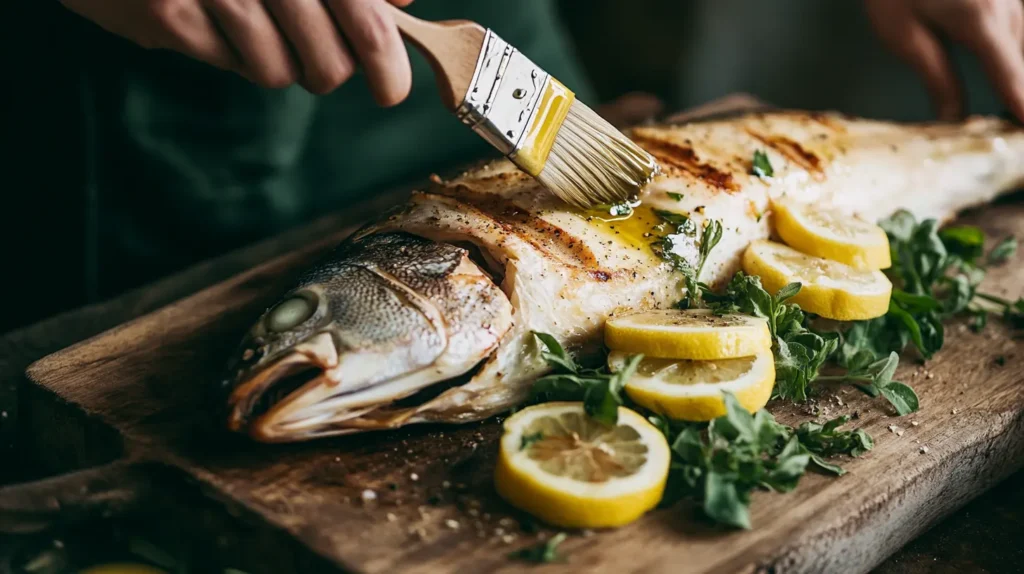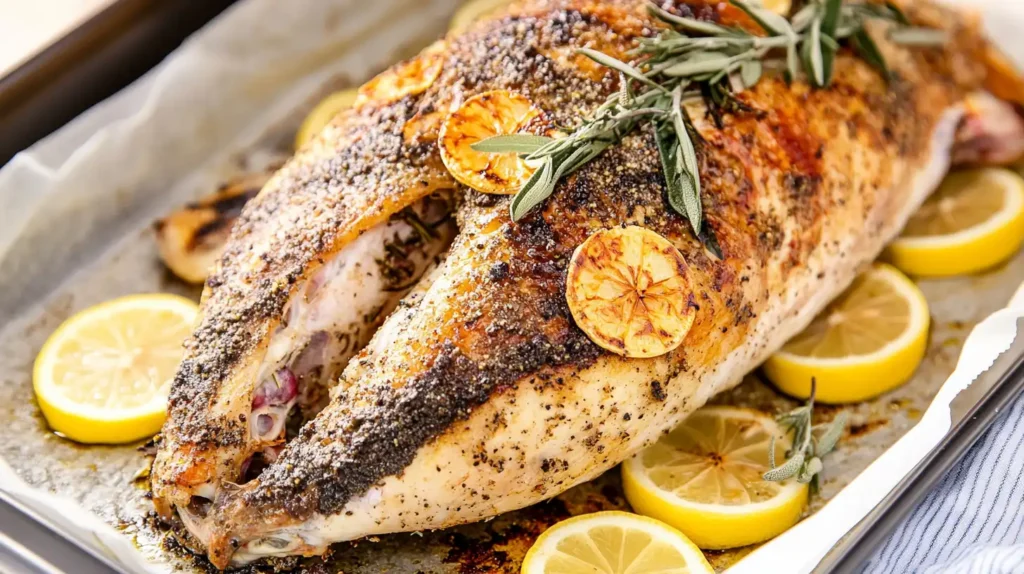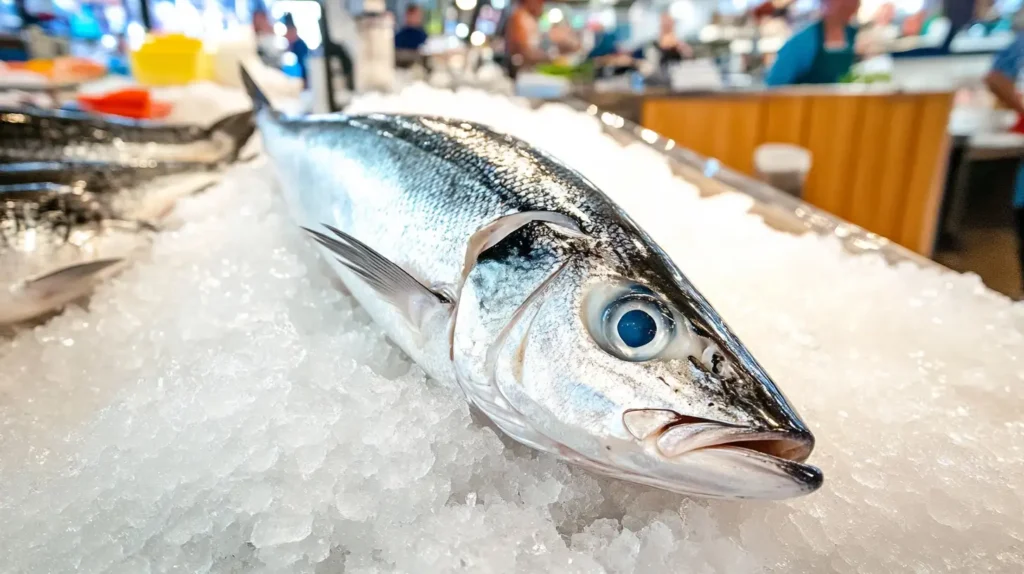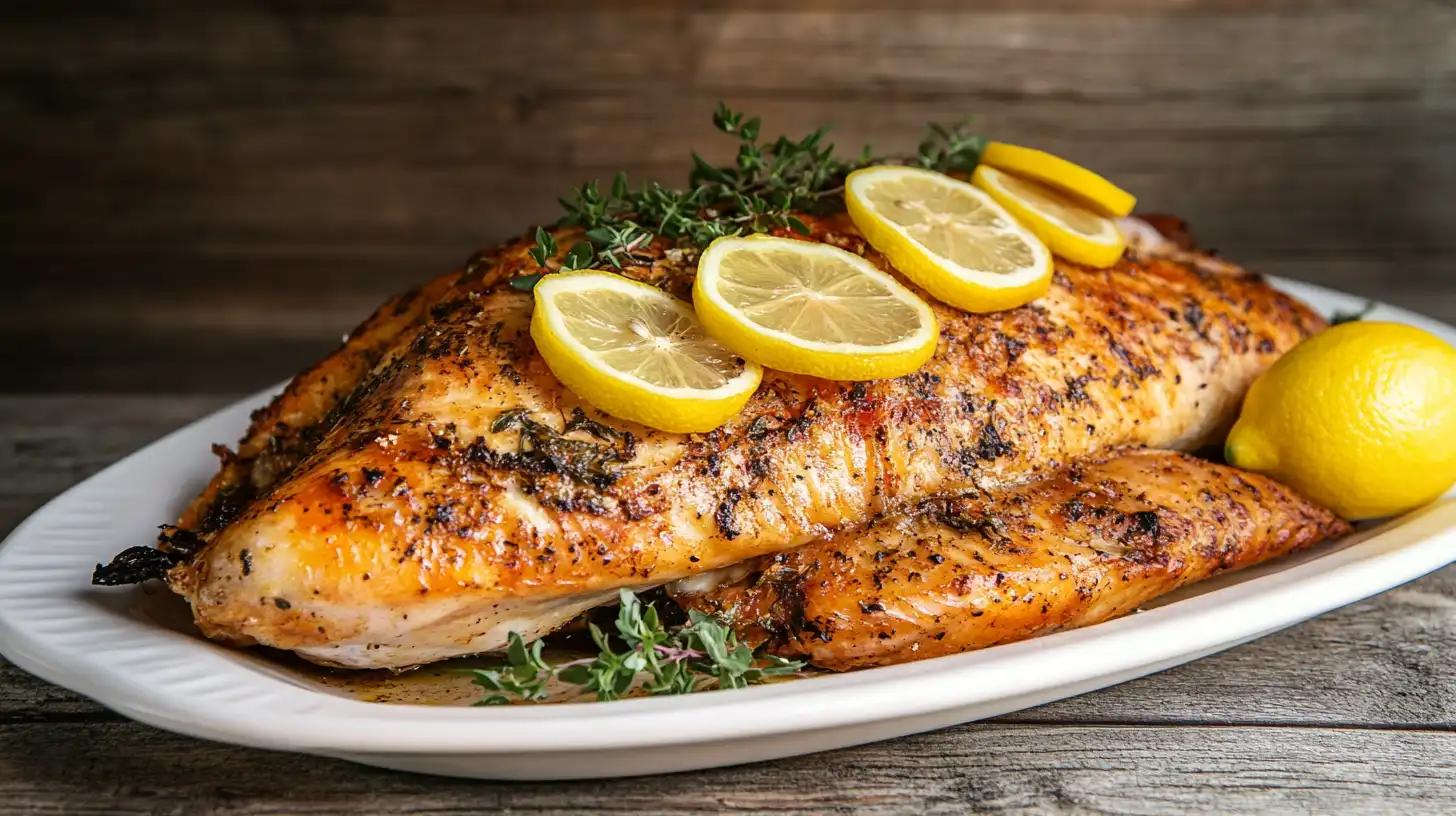Introduction
Branzino, often referred to as Mediterranean sea bass, has become a favorite fish for chefs and home cooks alike due to its mild, delicate flavor and flaky texture. However, one common question often arises: Is branzino farmed or wild caught?
The answer is that branzino can be both farm-raised and wild-caught, depending on its source. While farmed branzino is more readily available and sustainable, wild-caught branzino is valued for its natural diet and slightly more robust flavor. In this article, we’ll explore the differences between farmed and wild branzino, their benefits, potential drawbacks, and how to choose the best branzino for your table.
Farmed Branzino
How and Where Is Branzino Farmed?
Farmers raise branzino mainly in aquaculture facilities along the Mediterranean coast, especially in Greece, Turkey, and Italy. These farms carefully recreate the fish’s natural environment to ensure healthy growth. Large sea pens or tanks provide clean water, and farmers monitor the quality closely.
The fish eat a carefully designed diet that promotes growth and preserves their mild flavor. Because of this controlled process, farmed branzino is widely available in markets and restaurants around the world.
Benefits of Farm-Raised Branzino
Farmed branzino offers several benefits that make it a great choice for many consumers:
- Consistent Availability: Unlike wild-caught branzino, farmed fish are available year-round, which makes it easier to find them in stores.
- Affordable Prices: Farmed branzino usually costs less because fish farming allows for higher production levels.
- Sustainability: Well-managed fish farms help protect wild fish populations from overfishing.
- Uniform Quality: Farm-raised branzino tends to have a consistent size, flavor, and texture, which makes it ideal for cooking and presentation.

With these benefits, farmed branzino is an excellent option for everyday meals or special occasions. However, there are a few concerns to keep in mind.
Potential Concerns with Farmed Branzino
While farmed branzino has many positives, there are some challenges to consider:
- Environmental Impact: Poorly managed fish farms can harm local marine ecosystems by polluting the water. Choosing responsibly farmed fish helps minimize this impact.
- Diet Differences: Farmed branzino may not develop the same rich flavor as wild fish because they eat a controlled diet instead of their natural food sources.
- Use of Antibiotics: Some farms use antibiotics or chemicals to keep the fish healthy. To avoid this, look for farmed branzino with certifications like “ASC certified” (Aquaculture Stewardship Council).
When you buy farmed branzino, choose trusted suppliers or markets that follow ethical farming practices. This way, you can enjoy healthy, flavorful fish while supporting sustainable seafood choices.
Wild-Caught Branzino
Where Does Wild Branzino Come From?
Fishermen catch wild branzino in the Mediterranean Sea and parts of the eastern Atlantic Ocean. They use traditional fishing methods, such as small-scale nets or hand lines, to minimize harm to the environment. Wild branzino grows in its natural habitat, where it feeds on smaller fish, crustaceans, and plankton.
Advantages of Wild-Caught Branzino
Wild-caught branzino offers several unique benefits that set it apart:
- Rich Flavor: Wild branzino has a more complex flavor thanks to its natural diet. The taste is slightly stronger compared to farm-raised fish.
- Firm Texture: Because wild fish swim freely, their muscles develop more, resulting in firmer, flakier meat.
- No Additives: Wild branzino grows without human intervention, so it doesn’t contain antibiotics, artificial feed, or chemicals.
For those who appreciate high-quality seafood, wild-caught branzino is a top choice. Its natural diet and active lifestyle give it a distinct, premium taste.
Challenges of Sourcing Wild Branzino
Although wild-caught branzino offers great flavor, it can be harder to find. Here’s why:
- Seasonal Availability: Wild branzino is only available during certain fishing seasons, so it’s not always easy to purchase.
- Higher Cost: Because of limited supply and the labor involved in catching it, wild branzino tends to be more expensive.
- Sustainability Concerns: Overfishing in some areas threatens wild branzino populations. To ensure sustainability, choose fish that come from certified, responsible fisheries.

While wild branzino may cost more, it’s worth the price for its exceptional flavor and texture. If you can find it fresh and sustainably sourced, it’s a treat worth trying.
Farmed Branzino
How and Where Is Branzino Farmed?
Farmers raise branzino in aquaculture facilities located along the Mediterranean coast, particularly in Greece, Turkey, and Italy. These fish farms carefully replicate the branzino’s natural environment by using large sea pens or spacious tanks. Clean water and strict monitoring ensure the fish grow healthy and maintain their delicate texture.
Farmers feed branzino a high-quality diet designed to encourage steady growth while preserving the fish’s mild flavor. Because of this controlled process, farm-raised branzino has become widely available in markets and restaurants throughout the year. It’s a popular option for those who want fresh fish without waiting for seasonal catches.
Benefits of Farm-Raised Branzino
Farmed branzino offers several benefits, making it a practical and reliable choice for seafood lovers:
- Consistent Availability: Unlike wild branzino, farmed varieties are available year-round. This makes them much easier to find in grocery stores and fish markets.
- Affordable Prices: Branzino raised in aquaculture tends to cost less because farming increases production and keeps supply steady.
- Sustainable Practices: Well-managed fish farms reduce the need for wild fishing, which helps protect natural branzino populations.
- Uniform Quality: Farmed branzino is often uniform in size, texture, and taste. This consistency makes it ideal for home cooking or restaurant meals.
Farm-raised branzino works well for both everyday meals and special dinners. Its affordability and availability mean you can enjoy it whenever you like without breaking the bank.
Potential Concerns with Farmed Branzino
While farmed branzino has many positives, it does come with a few drawbacks worth noting:
- Environmental Impact: Poorly managed fish farms can pollute nearby waters and disrupt marine life. Choosing fish from certified, well-managed farms helps avoid this issue.
- Diet Differences: Unlike wild branzino, farmed fish eat a controlled diet that sometimes affects their flavor and nutritional quality. However, modern farms focus on creating balanced, nutritious feeds to maintain quality.
- Use of Antibiotics: Some fish farms rely on antibiotics to prevent disease. To avoid this, look for certifications like “ASC Certified” that ensure the use of safe, ethical practices.
By choosing responsibly sourced farmed branzino, you can enjoy its many benefits while minimizing environmental concerns. Check for labels like “ASC Certified” or ask your fishmonger for details on where the fish came from.
Wild-Caught Branzino
Where Does Wild Branzino Come From?
Fishermen catch wild branzino in its natural habitat, the Mediterranean Sea and parts of the eastern Atlantic Ocean. They often use traditional methods such as small nets or hand lines to minimize environmental impact. Because wild branzino grows in open waters, it benefits from a natural diet of small fish, crustaceans, and plankton.
Wild-caught branzino is highly prized for its quality and taste. Many seafood enthusiasts consider it a premium option due to its natural upbringing and slightly richer flavor.
Advantages of Wild-Caught Branzino
Wild branzino offers several advantages that make it a favorite among seafood lovers:
- Exceptional Flavor: Wild branzino’s natural diet gives it a richer, more complex taste compared to farmed varieties.
- Firm, Flaky Texture: Wild fish constantly swim and move in their natural habitat, which results in firmer meat with a delicate, flaky texture.
- Free of Additives: Since wild-caught branzino grows naturally, it doesn’t contain antibiotics, chemicals, or artificial feeds.
For those who value high-quality, naturally sourced seafood, wild branzino is an excellent choice. Its unique flavor and texture make it perfect for special occasions or premium meals.
Challenges of Sourcing Wild Branzino
While wild-caught branzino is delicious, sourcing it comes with a few challenges:
- Seasonal Availability: Wild branzino is subject to fishing seasons, so it may not always be available year-round.
- Higher Prices: Due to limited supply and the labor-intensive nature of traditional fishing, wild branzino often costs more than farmed options.
- Sustainability Concerns: Overfishing can threaten wild branzino populations. Choosing fish from certified sustainable fisheries helps protect these valuable stocks.
Despite these challenges, wild-caught branzino remains a worthwhile investment for seafood lovers who enjoy its premium quality and flavor. When purchasing, always look for sustainability certifications such as “MSC Certified” to support responsible fishing practices.
Farmed vs. Wild Branzino: Key Differences
Taste and Texture
When it comes to taste and texture, farmed and wild-caught branzino offer slightly different experiences. Wild-caught branzino tends to have a more robust and complex flavor because it feeds on a natural diet of small fish and crustaceans. This natural diet also gives wild branzino firmer, flakier flesh, which many seafood enthusiasts prefer.
On the other hand, farmed branzino has a milder, more subtle flavor. Because it grows in controlled environments with a consistent diet, its texture is softer and more uniform. This makes farmed branzino a great choice for those who enjoy delicate flavors or want a versatile fish for a variety of recipes.
Sustainability
Sustainability plays a significant role in the farmed vs. wild-caught debate. Responsible fish farming helps reduce the strain on wild fish populations. Many farms now operate under strict environmental guidelines to ensure clean water, ethical practices, and minimal impact on surrounding ecosystems. When you choose farmed branzino labeled “ASC Certified,” you are supporting farms committed to sustainability.
Wild-caught branzino, when sourced responsibly, can also be a sustainable option. Small-scale fisheries using traditional methods like hand lines or selective nets have less impact on marine ecosystems. However, overfishing in certain areas has led to concerns about the long-term health of wild branzino populations. To make an eco-friendly choice, look for “MSC Certified” labels that guarantee the fish was caught using sustainable practices.
Price and Availability
Farmed branzino is typically easier to find and more affordable than wild-caught varieties. Because fish farming operates year-round, it ensures a steady supply of branzino in grocery stores and restaurants. This consistent availability also makes it more budget-friendly, making farmed branzino an excellent option for everyday meals.
In contrast, wild-caught branzino is usually more expensive and harder to source. Its seasonal availability and the labor involved in traditional fishing methods drive up the cost. Wild branzino is often considered a premium choice, perfect for special occasions or for those looking to experience its exceptional flavor and texture.
Nutritional Differences
Both farmed and wild branzino are nutritious choices that offer lean protein, omega-3 fatty acids, and essential vitamins. However, the nutritional content may vary slightly. Wild branzino, with its natural diet, sometimes contains higher levels of omega-3 fatty acids, which are beneficial for heart and brain health. Farmed branzino still provides plenty of nutrients, but its exact nutritional profile depends on the quality of the feed used in aquaculture.
Regardless of whether you choose farmed or wild branzino, both options are excellent for a healthy, balanced diet. Pair your branzino with vegetables, whole grains, or a fresh salad for a meal that is both nutritious and satisfying.
How to Choose the Best Branzino
Choosing fresh branzino is the key to getting the best flavor and texture. Whether you’re buying farmed or wild-caught fish, these simple tips will help you pick the perfect one:

1. Check the Eyes
Look at the eyes first. Fresh branzino will have clear, bright eyes that look lively. Avoid fish with dull, cloudy, or sunken eyes because that means it’s not fresh.
2. Look at the Skin
The skin of fresh branzino should look shiny and moist with a smooth texture. It should have a natural, metallic glow. If the skin looks dry, patchy, or dull, the fish may not be as fresh as it should be.
3. Feel the Flesh
Gently press the fish with your finger. The flesh should feel firm and spring back into place. If it feels soft or leaves a dent, it’s a sign that the fish is no longer fresh.
4. Smell the Fish
Fresh branzino has a light, clean smell—like a breeze from the sea. If it smells overly strong, sour, or “fishy,” it’s better to pass on it. Trust your sense of smell; it’s a great way to check freshness.
5. Look for Certifications
For farmed branzino, look for labels like Aquaculture Stewardship Council (ASC). These labels show that the fish came from a farm that follows safe and eco-friendly practices.
If you prefer wild-caught branzino, check for certifications like the Marine Stewardship Council (MSC). This ensures the fish was caught in a way that protects marine life and the environment.
6. Shop at Trusted Sellers
Always buy branzino from trusted markets, fish counters, or fishmongers. Don’t hesitate to ask the seller when the fish was delivered or where it came from. Good sellers will be happy to share this information with you.
7. Choose Whole Fish
Whenever possible, buy whole branzino instead of pre-cut fillets. Whole fish stay fresh longer because the bones and skin protect the flesh. Cooking whole fish also locks in moisture and gives it more flavor. If you prefer fillets, make sure they look moist, firm, and evenly cut.
By following these tips, you’ll always choose the freshest and tastiest branzino. Whether you’re grilling, roasting, or pan-searing, starting with high-quality fish will make your dish shine!
If you enjoy branzino, you might also like recipes for other versatile fish like Rockfish Recipes, which offer similar cooking options.
Frequently Asked Questions
Is Farmed Branzino Safe to Eat?
Yes, farmed branzino is safe when sourced from trusted farms. Look for labels like ASC Certified to ensure it’s raised responsibly and sustainably.
Which Tastes Better: Farmed or Wild-Caught Branzino?
Wild-caught branzino has a stronger, richer flavor and firmer meat. Farmed branzino has a milder taste and softer texture. Both are delicious—it just depends on your preference.
How Can I Tell If Branzino Is Farmed or Wild?
Check the label. Farmed branzino often has certifications like ASC, while wild-caught may be labeled MSC Certified. Wild fish tend to vary slightly in size, while farmed ones look more uniform.
Is Branzino a Sustainable Choice?
Yes, both farmed and wild branzino can be sustainable. Choose ASC Certified for farmed fish or MSC Certified for wild-caught to support eco-friendly options. For a simple and flavorful preparation, try this Branzino Recipe that highlights its natural taste.
Can I Cook Branzino Whole?
Absolutely! Cooking branzino whole keeps it juicy and flavorful. Just season it with olive oil, lemon, and herbs, then roast, grill, or bake for a stunning dish.
How Do I Store Fresh Branzino?
Store fresh branzino in the fridge on ice and cook it within 1–2 days. For longer storage, freeze it in an airtight bag for up to 3 months. Thaw in the fridge before cooking.
Conclusion
Branzino is a tasty and easy-to-cook fish that works well in many recipes. Whether you choose farmed or wild-caught, this fish offers a mild flavor and tender, flaky meat. Farmed branzino is more affordable and easier to find, while wild branzino has a slightly richer taste and firmer texture.
When buying branzino, look for clear eyes, shiny skin, and trusted labels like ASC or MSC Certified. These tips help you choose the freshest and highest-quality fish. Simple seasonings like olive oil, lemon, and fresh herbs bring out its natural flavors.
So, why not give branzino a try? It’s healthy, easy to prepare, and perfect for any occasion—whether it’s a weeknight dinner or a special meal. You’ll love how simple and delicious it is!

